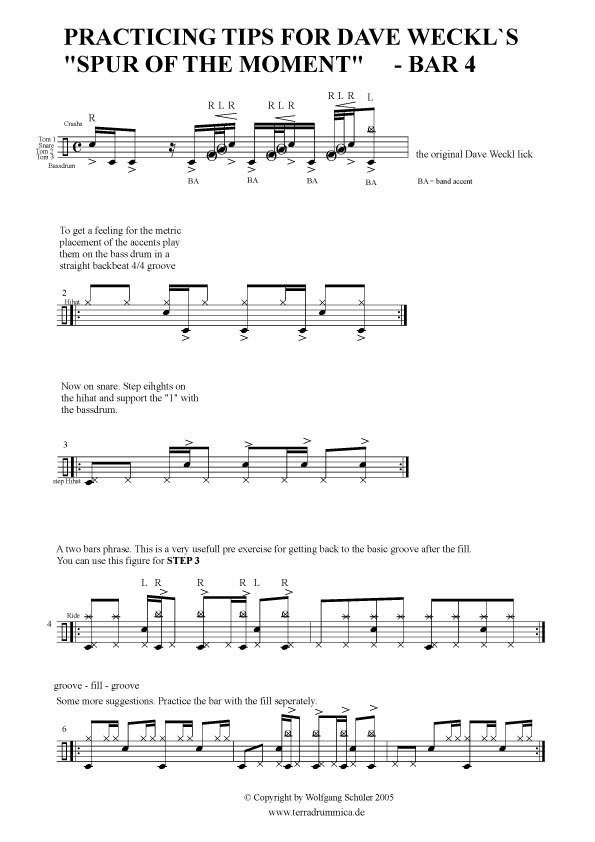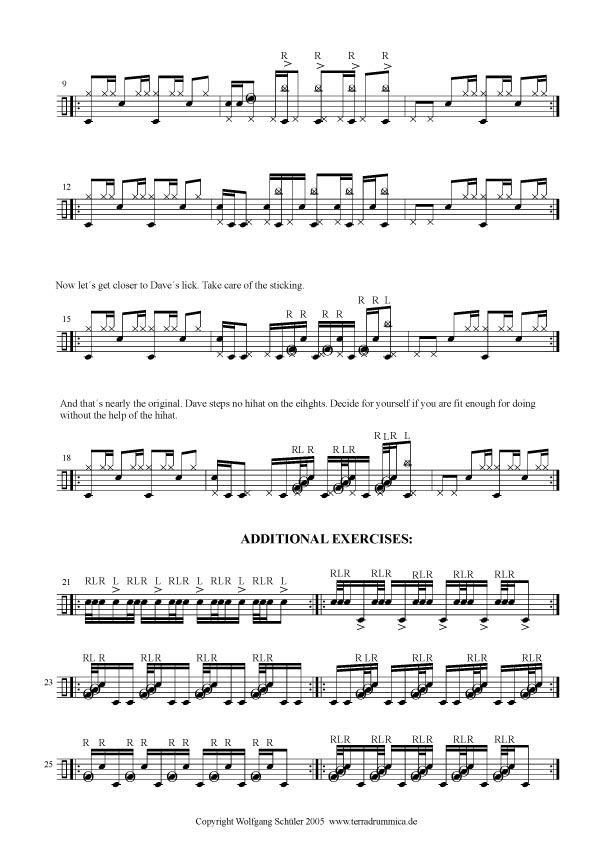How To Enter A Hard Dave Weckl Play Along
Explained on "Spur Of The Moment" from Dave Wecklīs "For The Contemporary Drummer"
This method not only works for this particular Weckl song, but for all play alongs. If a play along is "hard" depends on your drumming abilities.
There are other demanding play alongs like e.g. Marc Atkinsonīs "Unreel book" (Iīm planing on writing an extra article about this book) and my "Transcriptionbook" can also be concerned as a "play along book".
When you are faced with a difficult play along arrangement the first time, youīll might have no idea how to start and structure the work on it. With this article I will show you a method for efficient work. Iīm a great fan of Dave Wecklīs educational work (and of his drumming too) and Iīve choosen "Spur Of The Moment" because itīs a song that features a bundle of classical drumming challenges:
- beat displacement
- tricky accents
- a 32 bar drumsolo build up over a vamp
- playing synchron lines with the band
Letīs begin:
1a. The first thing I do is listen to the song as often as possible (while driving in my car, while doing the dishes...) to get real familiar with it.
1b. In parallel I start playing along the song with a closed headphone on my drumset. The important thing is: I donīt try to catch up with all the accents and all that stuff but to groove along with it. Usually I play some very simple grooves and fills.
2. After that I sit down and read accurately the text that Dave has written about this tune. His explanations are great and he gives important tips of how to handle the song. He doesnīt tell you "you have to play this and that" but he explains very intelligent what he thought while playing his drumpart.
When Iīm sure that Iīve understood all of it I take the next step:
3. I play along and try to catch up with the accents and stops. The leadsheed can be helpful for this. And donīt forget the memory cache of your brain, especially in the hearing region.
From this point on I start recording myself as I play along with the muted drum track version.
I listen to my recording and analyse it. What was good - what was shit?
In case there is a good fill or groove Iīve done, I transcribe it for later.
The first few tries might be a bit frustrating. Thatīs for different reasons:
- If you havenīt got the equipment for professional drum recording your set will sound miserable compared to the play along track and miserable compared to Daveīs drumsound. But you will learn to live with it (or go and get yourself some exclusive drum mics, a digital mixing console, gate, reverb, EQīs and stuff). Yes, you can see it as an advantage: in case you manage to get a bearable recording result with one battered mic you can be sure that youīve done a real good job!
- playing with a play along is the ultimate test of your timing. You not only habe to keep the time but your quantisation has to be absolut the same as in the track. Michael Brecker, Jay Oliver and John Patitucci arenīt machines and it might take a little while for you to get into their typical quantisation and phrasing.
- especially beginners will make the experience that they play much to much notes. You arenīt playing a drumsolo but you join along with a band. Even if it might sound so Dave isnīt playing 32nds all the time. There are some situations where he plays a real big fill in, but most of the time he plays one groove with little variations.
What he plays exactely you will see in the next chapter:
4.The scores. Dave has transcribed some of his grooves, fills and solo figures. I have problems with reading a drumpart divided in two or three systems. So I write down the notes in the form that Iīm used to. Itīs worth the time of doing it.
Daveīs drumming sounds great but perhaps you will be a little shocked when you see his transcriptions. His style of playing requires real high abilities on the drumset. Velocity and precision for the execution of complex coordination figures are two of the most important features of Wecklīs drumming technique.
In case you have problems with his licks I strongly recommend to order my DRUMMETHOD VOLUME 2 and work through it. Also make use of the
X-step methode
that I explained in my "free online lessons" on this site.
Dave always points out that you donīt have to play excactely the same stuff he played, but I think that itīs the real challenge to be able to play Daveīs stuff but also a self created drumpart too.
5. One important point is: you might be able to play a certain figure on your drums when you play alone without the "stress" of the irritation done by other instruments playing different rhythms and stuff. So are you able to play that figure with the play along?
One good way of practicing is to use PC or laptop with a wave editor programm. You donīt have to own WaveLab 5.0 for that.
There are some fine freeware editors available in the internet - I highly recommend "AUDACITY" an exellent freeware wave editor.
Letīs say there is a complex figure over two bars. So load the song into the wave editor and marc 4 bars before and 4 bars after the figure and turn on the loop function. Now you should get into it - if not, you should practice the figure solo and perhaps go back to a slower tempo
(what is also possible with "Audacity").
Loops that I have to practice for more than one day I cut out in the wave editor and save them as an extra file because it often takes some time to find the correct start and ending marcs.
6. Creating a musical 32 bars drum solo over the vamp isnīt quite easy. Dave gives a good example of doing that.
You have three possibilities of working it out:
a) you transcribe Daveīs solo (or wait a bit until Iīve posted the transcription on my site).
b) you compose and write down your own solo (I plan on posting the scores of my personal solo here too).
c) you improvise and hope to find some good stuff that fits to the keyboards and bass lines.
Short check:
1a/1b: Get familiar with the song by listening to it and by playing along with it using simple grooves and fill ins.
2: Read the explanation texts.
3: Play along and try to to catch up with the accents and stops. Record yourself and analyse it.
4: Start to work on Daveīs transcriptions.
5: Practice with a wave editor.
6: Work out the drumsolo.
EXAMPLE:

